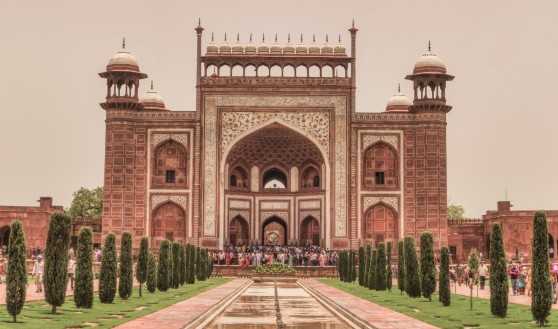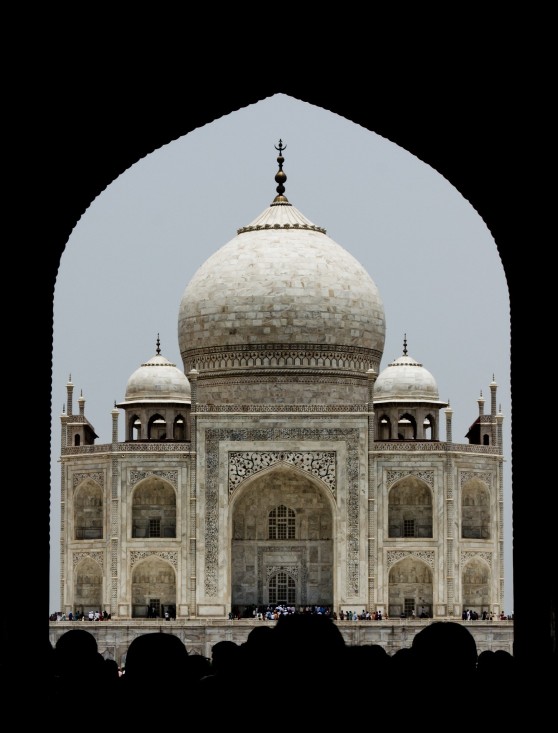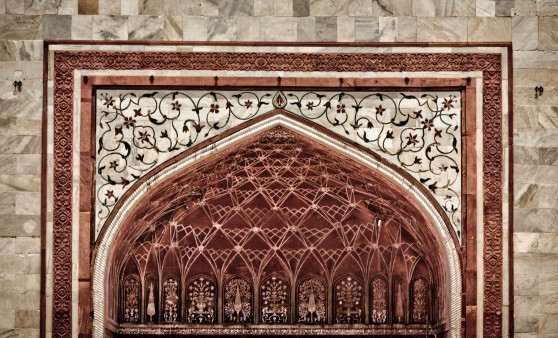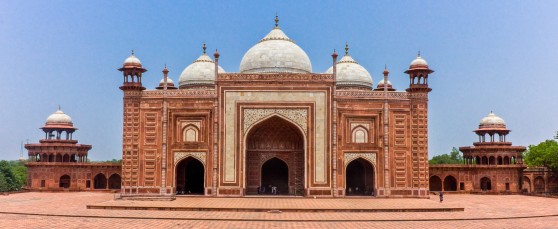The Taj Mahal looms fairytale-like from the banks of the Yamuna River. It’s India’s most recognized monument and is also one of the Seven Wonders of the World. The Taj Mahal has a rich history dating back to 1630 AD. It’s made out of marble and took 22 years and 20 000 workers to complete. Words cannot do the Taj Mahal justice, its incredible detail simply has to be seen to be appreciated.
The Taj is the most beautiful monument built by the Mughals, the Muslim rulers of India. Taj Mahal is built entirely of white marble. Its stunning architectural beauty is beyond adequate description, particularly at dawn and sunset. It seems to glow in the light of the full moon. On a foggy morning, the visitors experience it as if suspended when viewed from across the Yamuna river. It is an “elegy in marble” or some say an expression of a “dream”.
You get to see some exquisite Mughal carving work right at the entry gates. I loved the ceiling patterns carved in marble and stone. Also, the axial line view of the dome from the entry gate arch is something special!
Taj Mahal (meaning Crown Palace) is a Mausoleum that houses the grave of queen Mumtaz Mahal at the lower chamber. The grave of Shah Jahan was added to it later. The queen’s real name was Arjumand Banu. In the tradition of the Mughals, important ladies of the royal family were given another name at their marriage or at some other significant event in their lives, and that new name was commonly used by the public. Shah Jahan’s real name was Shahab-ud-din, and he was known as Prince Khurram before ascending to the throne in 1628.
In all, the Taj Mahal covers an area of 60 bighas, as the terrain gradually sloped from south to north, towards the river, in the form of descending terraces. At the southern point is the forecourt with the main gate in front and tombs of Akbarabadi Begum and Fatehpuri Begum, two other queens of Shah Jahan, on its south-east and south-west corners respectively called Saheli Burj 1 and 2. The Taj stands on a raised, square platform (186 x 186 feet) with its four corners truncated, forming an unequal octagon. The architectural design uses the interlocking arabesque concept, in which each element stands on its own and perfectly integrates with the main structure. It uses the principles of self-replicating geometry and a symmetry of architectural elements.
Its central dome is fifty-eight feet in diameter and rises to a height of 213 feet. It is flanked by four subsidiary domed chambers. The four graceful, slender minarets are 162.5 feet each. The entire mausoleum (inside as well as outside) is decorated with inlaid design of flowers and calligraphy using precious gems such as agate and jasper. The main archways, chiseled with passages from the Holy Qur’an and the bold scroll work of flowery pattern, give a captivating charm to its beauty. The central domed chamber and four adjoining chambers include many walls and panels of Islamic decoration.You can visit the Taj Mahal from 6 a.m. to 7 p.m. every day except Friday (when it’s closed for prayer). The Taj Mahal is also open for moonlight viewing from 8.30 p.m. until 12.30 a.m., two days before and after each full moon. For foreigners, the entrance fee to the Taj Mahal consists of a 250 rupee Entry Tax (Archeological Society of India) and 500 rupees Toll Tax (Agra Development Authority). Indian nationals only pay is 20 rupees. Children younger than 15 years are free. Night time tickets cost 750 rupees for foreigners and 500 rupees for Indian nationals, for half an hour’s admittance. These tickets must be purchased 24 hours in advance. The Taj Mahal appears to gradually alter its color in the changing light of the day. It’s well worth the effort to get up early and spend sunrise there, as it majestically reveals itself. Be prepared to encounter plenty of beggars and touts at the entrance. If you don’t want to pay the costly admission fee or battle the crowds, you can get a great view of the Taj from across the river bank. Once such place there is Mehtab Bagh — a 25 acre Mughal garden complex directly opposite the monument. The entry cost is 100 rupees for foreigners, and it’s open until sunset. The view is one to remember!
A good time to visit the Taj Mahal would be during the week long Taj Mahotsav that takes place at Shilpgram in Agra, right near the Taj Mahal, from February 18-27 each year. The focus of this festival is on arts, crafts, Indian culture, and recreating the Mughal era. It gets underway with a spectacular procession that includes elephants, camels, and drummers. Elephant and camel rides are on offer, and there are also games for the kids, and a food festival. The venue has special significance, as it’s apparently located on the site where the artisans who built the Taj Mahal once lived.
Apart from the Taj Mahal, you should visit the Agra Fort, picture above. It is massive and very well maintained. It was used as barracks and a statuon office by Indian Army till recently and a part of it still continues to be under their control. There are also many side trips possible that you can make during an extended weekend. The deserted Mogul capital of Fatehpur Sikri is 40 kilometers from Agra and can easily be visited on a day trip. Nature lovers will appreciate a trip to the Bharatpur Bird Sanctuary at the Keoladeo Ghana National Park, 55 kilometers from Agra. Another place of interest is the beautifully carved, red ocher sandstone tomb that’s Akbar’s Mausoleum. It’s located at Sikandra, only 13 kilometers from Agra.









eating and hospitality comes in Agra as well.If you ever visit Agra,hotels in Agra give you a perfect chance to witness what India is all about.